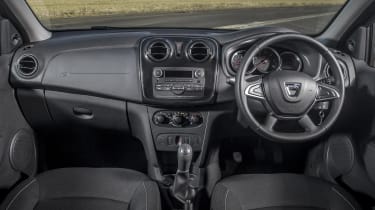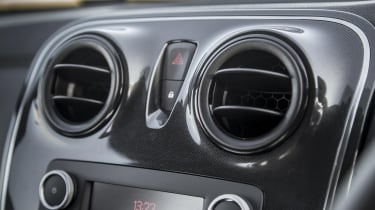Dacia Sandero hatchback - Interior & comfort (2013-2020)
The Dacia Sandero hatchback’s cabin is dull but worthy
Although far from a design classic, the simple, well-ordered interior of the Dacia Sandero isn’t as bad as you might think. It’s basic, functional and the materials are hard to the touch, where the majority of rivals have smarter, soft-touch materials but it does the trick when you consider what you’ve paid. It’s also very roomy – a big advantage the Sandero has over its costlier rivals.
Dacia Sandero dashboard
The Sandero’s dashboard isn't covered in soft-touch plastics, but it's functional and looks pretty tough, so it should stand up to the rigours of family life. One indication of cost-cutting is the lack of full seat and steering-wheel adjustment on all but the top-spec version, so you might struggle to find the perfect seating position. The front seats look basic, but they offer enough support for longer trips, while rear-seat passengers should be happy, too.
The Sandero has undergone a number of improvements inside and out since it was facelifted. The quality of interior materials has improved, while the new, four-spoke steering wheel looks better than the old three-spoke job; although we found it to have a curiously sticky texture. Time will tell if that lessens with extended use.
Equipment
The entry-level Dacia Sandero Access recalls simpler times when you were grateful for merely having a car at all - it even eschews a radio (although it does have the right connections to allow you to fit your own). Many have commended it for its fuss-free, no-nonsense specification, which eliminates any frivolous features you don’t strictly need to drive in safety and efficiency. Buyers can clearly see that their investment has been in the Sandero’s body, seats and all the mechanical apparatus that helps it move along the road, without any further garnish.
More reviews
This thin premise is lost on most, though, and the Access is far less popular than the mid-range Essential model. Not representing a huge leap in cost, especially if you’re paying monthly, the Ambiance is far more in touch with the expectations of today’s motorist, with air-conditioning, electric front windows, remote central locking and other niceties that are now viewed as essentials. There’s a DAB radio with Bluetooth, too, and body-coloured bumpers that don’t shout ‘entry-level’ like the matt-grey Access ones do.
The top-spec Comfort model is actually rather well kitted-out for a small car, and costs about the same as entry-level versions of other cars. Fitted as standard are a trip computer, rear parking sensors and cruise control with a speed limiter. It also has a seven-inch infotainment system with sat nav, Apple CarPlay and Android Auto.
Options
The entry-level Access trim’s options list is pretty brief – the only box you can tick is an emergency spare wheel. This is in keeping with the brand’s ‘less is more’ philosophy, although it does seem strange that Dacia fits a ‘radio pre-equipment pack’ to support a future stereo installation, but doesn’t offer the latter itself.
This means that you can’t cherry-pick the features you simply can’t live without: you’re forced up to Essential specification if you want air-conditioning or central locking. This also unlocks a greater range of options, including a height-adjustment pack that allows you to change the height of the steering wheel, driver's seat and seatbelt. Sanderos in range-topping Comfort trim, meanwhile, can be fitted with a reversing camera.














